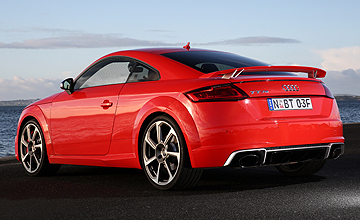BY TUNG NGUYEN | 15th Jun 2017

The first application of the new alloy five-pot engine, the TT RS beats the new RS3 sedan to market by mere weeks.
With 294kW/480Nm on tap with a distinct 1-2-4-5-3 cylinder firing order, the powerplant is easily one of the most likeable elements of the new-generation TT RS.
Peak power comes relatively late in the rev range at 5900-7000rpm, but maximum torque is available early, from 1700 to 5850rpm, ensuring plenty of prod whenever the go pedal is prodded.
Zero to 100km/h comes in just 3.7 seconds in the Coupe, while the Roadster will do the sprint in 3.9s – which makes the TT RS quicker than much more expensive and higher-powered vehicles on the market.
The low kerb weight helps too, with just 1440kg to lug around, the TT RS Coupe feels nimble and eager to attack corners.
Our drive route from Melbourne airport east to Yarra Glen, then south to Pakenham and through to Phillip Island, hinted at the potent potential of the TT RS, but out on public roads, the upper limits of the rev range could not be explored.
However, public streets highlighted the TT RS’ stiff ride, despite selectable drives modes which include a comfort setting.
Other modes, including dynamic, auto and individual, can be used to stiffen Audi’s magnetic ride suspension, sharpen steering and decrease shift times, but we found the best setting to be auto – able to change vehicle characteristics on the fly for whatever the situation requires.
We appreciate Audi’s inclusion of an independent exhaust select button, switchable between standard and sport, to open the taps of the bi-modal system without having the rest of the settings on hardcore mode.
In terms of styling, we think the new TT RS can’t quite match the handsome and svelte styling of the outgoing model, but some will love the new look.
To add to the sporty theme, Audi has added an RS specific bodykit with a redesigned front bumper, honeycomb grille, rear diffuser, oval exhaust pipes and fixed spoiler, and from the front and rear the TT RS gives a menacing and sporty look.
However, from the side, the only giveaway that this is Audi’s highest performing TT is new 20-inch wheels and RS-branded brakes. We wish Audi did more to differentiate its flagship from the standard model, but again, it is a matter of taste.
Inside, the cabin retains the minimalist but functional aesthetic as the base third-generation model and works just as well in a TT RS – the fewer distractions the better.
The RS-branded seats are some of the best sports seats we’ve sat in, providing support to the shoulders and hips without feeling too snug or claustrophobic.
A heating function is also a nice touch, and Roadster versions gain a seatbelt-mounted microphone for clearer phone calls and a neck-warming feature.
The rear seats remain as borderline useless as before, with only the smallest of children or contortionist able to sit comfortably behind an adult driver and passenger.
We wonder if Audi should have just thrown the seats out to save weight or put a roll cage in its place to increase rigidity.
However, anyone placing an order for a circa-$140k sportscar will likely not worry about the rear seats or ride comfort through the Victorian countryside, they’d worry about its on-track performance.
Luckily, after four hours on the road, Audi let us have a few laps of the Phillip Island Circuit to stretch the TT RS’ – and our – legs.
While the TT RS is a capable and competent sportscar on the open road, it transforms into a tarmac-devouring, supercar-slaying weapon on the racetrack.
Audi’s Quattro all-wheel-drive system is confidence inspiring, able to find grip mid-corner for almost unbelievable corner-exit speeds, while the dynamic mode hones each of the TT RS’s elements to razor sharp precision.
The new TT RS also loses the manual gearbox its predecessor was first offered in. Audi says the majority of customers opted for the automatic when it was made available, but we did miss the three pedals while driving through country Victoria.
The seven-speed automatic though, is a competent and compliant unit, quickly downshifting when we needed a squirt of power and up-shifting seamlessly.
Out on the track however, pelting the TT RS around the bends at over 150km/h, we were glad we didn’t have another element like shifting to worry about and shifting purists can always flick the TT RS into manual mode and use the steering wheel-mounted paddles.
Don’t be surprised to see the TT RS shaming much more expensive and exotic cars around the world, it’s that good.
The one downside we could level with its track performance is that after around 20 laps, the standard issue brakes started to fade.
However, customers can option ceramic brakes to alleviate the issue for a price of $8900. If we were the track-faring type, this is a must-get accessory.
The best sportscars are able to juggle capable on-track performance with engaging on-road dynamics and Audi’s new TT RS certainly delivers on both fronts.
The high pricetag or impracticable two-door body style may scare away some buyers who’d opt for its RS3 siblings, and while both cars may come close to on-road performance, the TT RS is definitely a winner on the circuit.